Short Circuit and Broken Rotor Faults Severity Discrimination in Induction Machines Using Non-invasive Optical Fiber Technology
Abstract
:1. Introduction
- Biomedical engineering: development of a surgical robotic system for less-invasive treatment of osteolysis [6]; force sensor with an ortho-planar spring-based flexure for surgical needle insertion [7,8]; robot-assisted eye surgery [9], and temperature monitoring during thermal ablation procedure [10]
- Electrical engineering: temperature monitoring of the lithium-ion batteries crucial for large scale deployment of electric vehicles and their second life power grid support application [11,12]; galloping monitoring of power transmission lines [13]; condition monitoring of an oil-immersed commercial distribution power transformer [14]
Basic FBG Sensing Principle
2. Methods
3. Results and Discussion
3.1. Positioning FBG-T Sensor
3.2. FBG-T Magnetic Flux Calibration
3.3. FBG-T Fault Severity Discrimination
4. Conclusions
Author Contributions
Funding
Institutional Review Board Statement
Informed Consent Statement
Data Availability Statement
Conflicts of Interest
References
- Zamudio-Ramirez, I.; Osornio-Rios, R.A.A.; Antonino-Daviu, J.A.; Razik, H.; Romero-Troncoso, R.D.J. Magnetic Flux Analysis for the Condition Monitoring of Electric Machines: A Review. IEEE Trans. Ind. Inform. 2021, 1. [Google Scholar] [CrossRef]
- Rosolem, J.B.; Penze, R.S.; Floridia, C.; Bassan, F.R.; Peres, R.; da Costa, E.F.; Silva, A.D.A.; Coral, A.D.; Junior, J.R.N.; Vasconcelos, D.; et al. Dynamic Effects of Temperature on FBG Pressure Sensors Used in Combustion Engines. IEEE Sens. J. 2020, 21, 3020–3027. [Google Scholar] [CrossRef]
- Rente, B.; Fabian, M.; Vidakovic, M.; Sunarho, J.; Bustamante, H.; Sun, T.; Grattan, K.T.V. A Fiber Bragg Grating (FBG)-Based Sensor System for Anaerobic Biodigester Humidity Monitoring. IEEE Sens. J. 2021, 21, 1540–1547. [Google Scholar] [CrossRef]
- Kumar, J.; Singh, G.; Saxena, M.K.; Prakash, O.; Dixit, S.K.; Nakhe, S.V. Development and Studies on FBG Temperature Sensor for Applications in Nuclear Fuel Cycle Facilities. IEEE Sens. J. 2021, 21, 7613–7619. [Google Scholar] [CrossRef]
- Li, H.; Xu, G.; Gui, X.; Liang, L.; Li, Z. An FBG Displacement Sensor in Deformation Monitoring of Subway Floating Slab. IEEE Sens. J. 2020, 21, 2963–2971. [Google Scholar] [CrossRef]
- Sefati, S.; Hegeman, R.; Alambeigi, F.; Iordachita, I.; Kazanzides, P.; Khanuja, H.; Taylor, R.H.; Armand, M. A Surgical Robotic System for Treatment of Pelvic Osteolysis Using an FBG-Equipped Continuum Manipulator and Flexible Instruments. IEEE/ASME Trans. Mechatron. 2021, 26, 369–380. [Google Scholar] [CrossRef] [PubMed]
- Shi, C.; Tang, Z.; Wang, S. Design and Experimental Validation of a Fiber Bragg Grating-Enabled Force Sensor with an Ortho-Planar Spring-Based Flexure for Surgical Needle Insertion. IEEE Trans. Med. Robot. Bionics 2021, 3, 362–371. [Google Scholar] [CrossRef]
- Zhang, T.; Chen, B.; Zuo, S. A Novel 3-DOF Force Sensing Microneedle with Integrated Fiber Bragg Grating for Microsurgery. IEEE Trans. Ind. Electron. 2021, 69, 940–949. [Google Scholar] [CrossRef]
- Ebrahimi, A.; Urias, M.G.; Patel, N.; Taylor, R.H.; Gehlbach, P.; Iordachita, I. Adaptive Control Improves Sclera Force Safety in Robot-Assisted Eye Surgery: A Clinical Study. IEEE Trans. Biomed. Eng. 2021, 68, 3356–3365. [Google Scholar] [CrossRef] [PubMed]
- De Tommasi, F.; Massaroni, C.; Carnevale, A.; Presti, D.L.; De Vita, E.; Iadicicco, A.; Faiella, E.; Grasso, R.F.; Longo, U.G.; Campopiano, S.; et al. Fiber Bragg Grating Sensors for Temperature Monitoring During Thermal Ablation Procedure: Experimental Assessment of Artefact Caused by Respiratory Movements. IEEE Sens. J. 2021, 21, 13342–13349. [Google Scholar] [CrossRef]
- Peng, J.; Jia, S.; Yu, H.; Kang, X.; Yang, S.; Xu, S. Design and Experiment of FBG Sensors for Temperature Monitoring on External Electrode of Lithium-Ion Batteries. IEEE Sens. J. 2021, 21, 4628–4634. [Google Scholar] [CrossRef]
- Rente, B.; Fabian, M.; Vidakovic, M.; Liu, X.; Li, X.; Li, K.; Sun, T.; Grattan, K.T.V. Lithium-Ion Battery State-of-Charge Estimator Based on FBG-Based Strain Sensor and Employing Machine Learning. IEEE Sens. J. 2021, 21, 1453–1460. [Google Scholar] [CrossRef]
- Zou, H.; Lu, M. Developing High-Frequency Fiber Bragg Grating Acceleration Sensors to Monitor Transmission Line Galloping. IEEE Access 2021, 9, 30893–30897. [Google Scholar] [CrossRef]
- Badar, M.; Lu, P.; Wang, Q.; Boyer, T.; Chen, K.P.; Ohodnicki, P.R. Real-Time Optical Fiber-Based Distributed Temperature Monitoring of Insulation Oil-Immersed Commercial Distribution Power Transformer. IEEE Sens. J. 2021, 21, 3013–3019. [Google Scholar] [CrossRef]
- Sarkar, S.; Inupakutika, D.; Banerjee, M.; Tarhani, M.; Shadaram, M. Machine Learning Methods for Discriminating Strain and Temperature Effects on FBG-Based Sensors. IEEE Photon. Technol. Lett. 2021, 33, 876–879. [Google Scholar] [CrossRef]
- Perikala, M.; Pathi, V.V.L.; Rajan, L.S.; Pandey, P.C. Cantilever Supported Fiber Bragg Grating Flow Sensor for Space Applications. IEEE Sens. J. 2021, 21, 2651–2657. [Google Scholar] [CrossRef]
- Wang, Y.-L.; Tu, Y.; Tu, S.-T. Development of Highly-Sensitive and Reliable Fiber Bragg Grating Temperature Sensors With Gradient Metallic Coatings for Cryogenic Temperature Applications. IEEE Sens. J. 2021, 21, 4652–4663. [Google Scholar] [CrossRef]
- Schwartz, M. Refraction and Reflection, Lecture Note. Available online: https://scholar.harvard.edu/files/schwartz/files/lecture15-refraction.pdf (accessed on 10 October 2021).
- Marcelo, M.; Regina, C.S.B.; Allil, B.A.; de Nazar, F.V.B. A Guide to Fiber Bragg Grating Sensors. In Current Trends in Short- and Long-period Fiber Gratings; InTech: London, UK, 2013. [Google Scholar]
- Alalibo, B.P.; Cao, W.-P.; Gbadebo, A.; Aarniovuori, L.; Cai, K. Investigation of the effect of bonding points on metal surface-mounted FBG sensors for electric machines. Prog. Electromagn. Res. C 2019, 97, 255–265. [Google Scholar] [CrossRef] [Green Version]
- FBGS Technologies. FBG Principle. Available online: http://www.fbgs.com/technology/fbg-principle/ (accessed on 28 November 2017).
- Mohammed, A.; Sarma, N.; Djurovic, S. Fibre optic monitoring of induction machine frame strain as a diagnostic tool. IEEE IEMDC 2017, 1–7. [Google Scholar] [CrossRef]



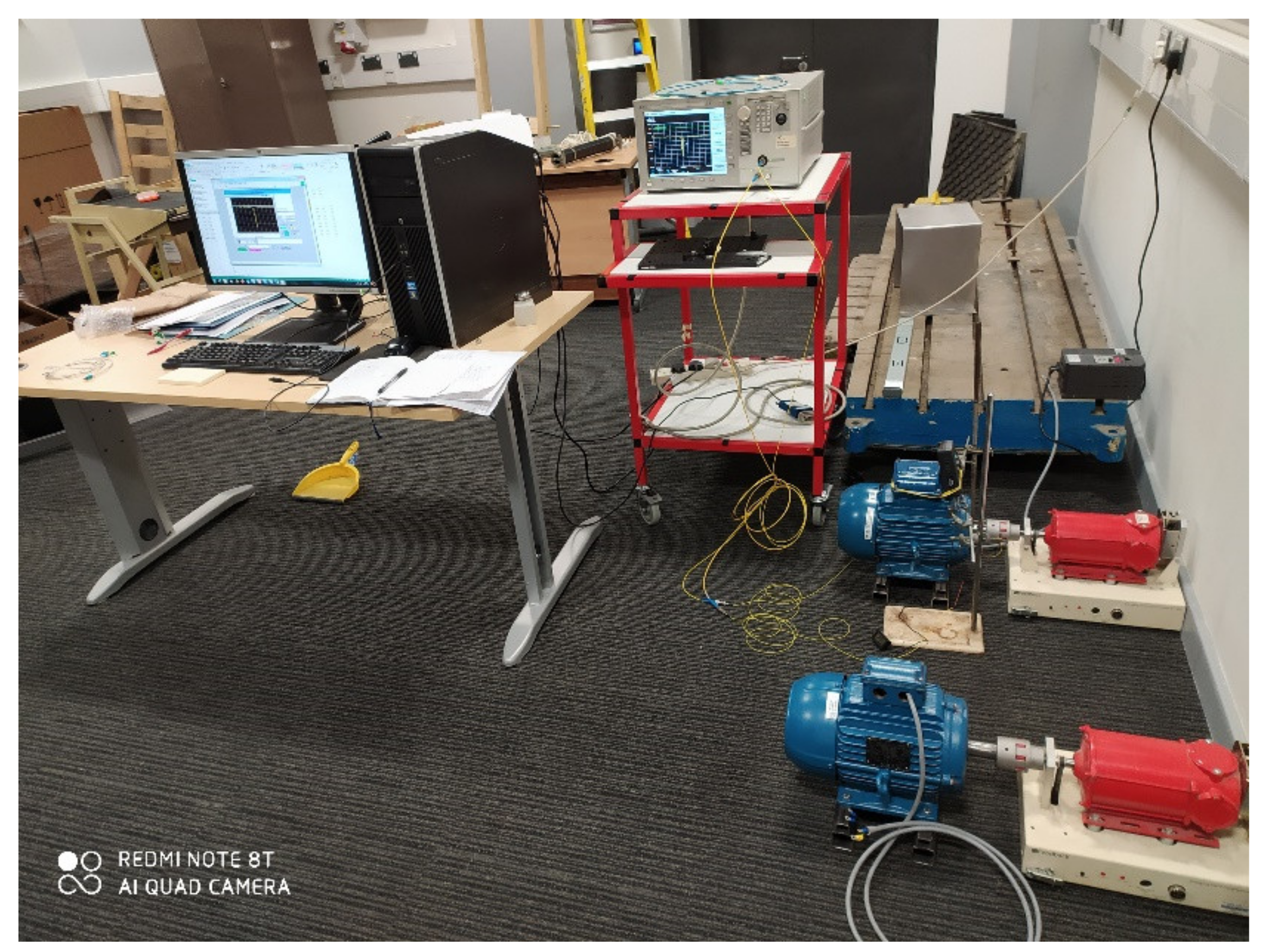


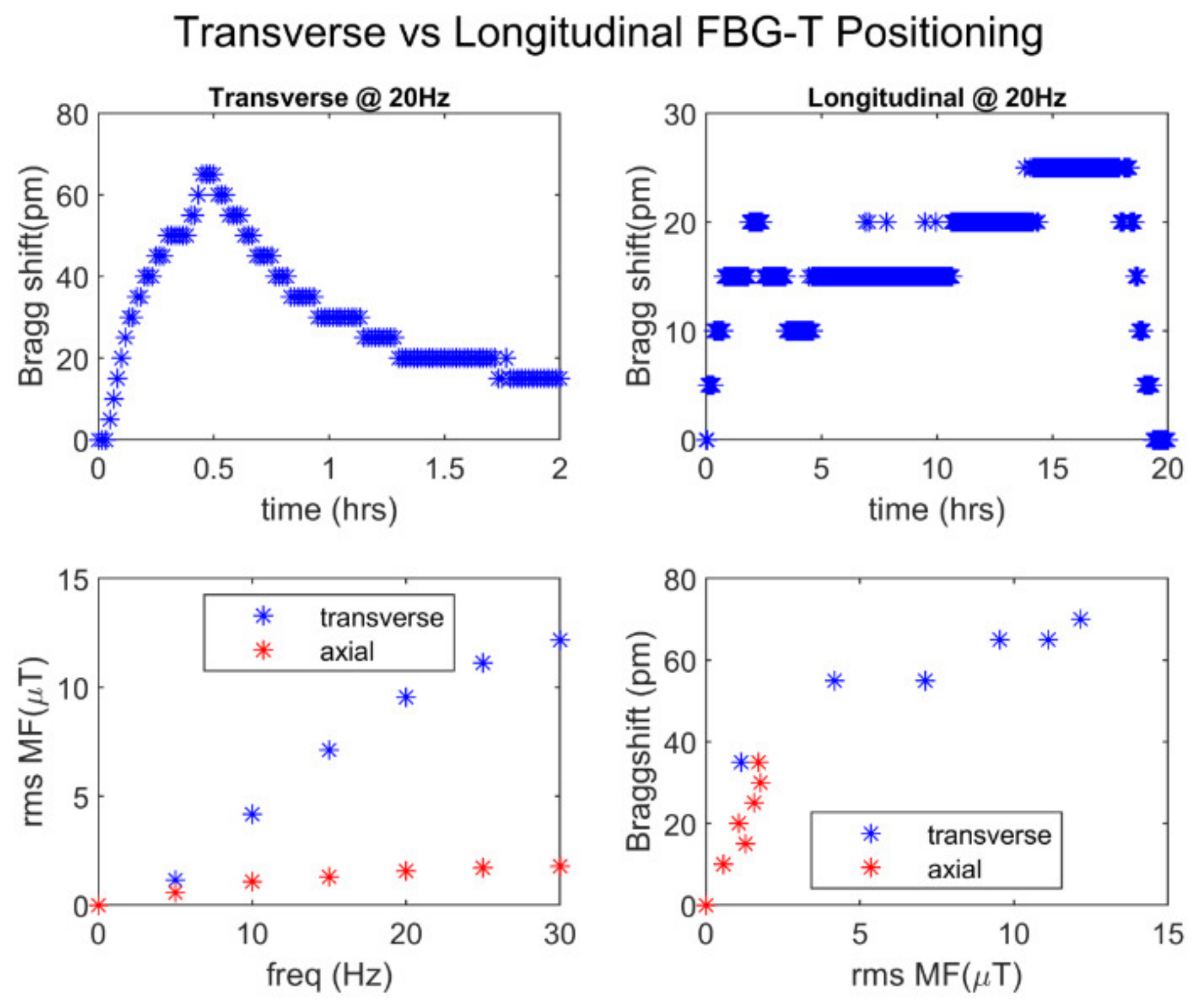


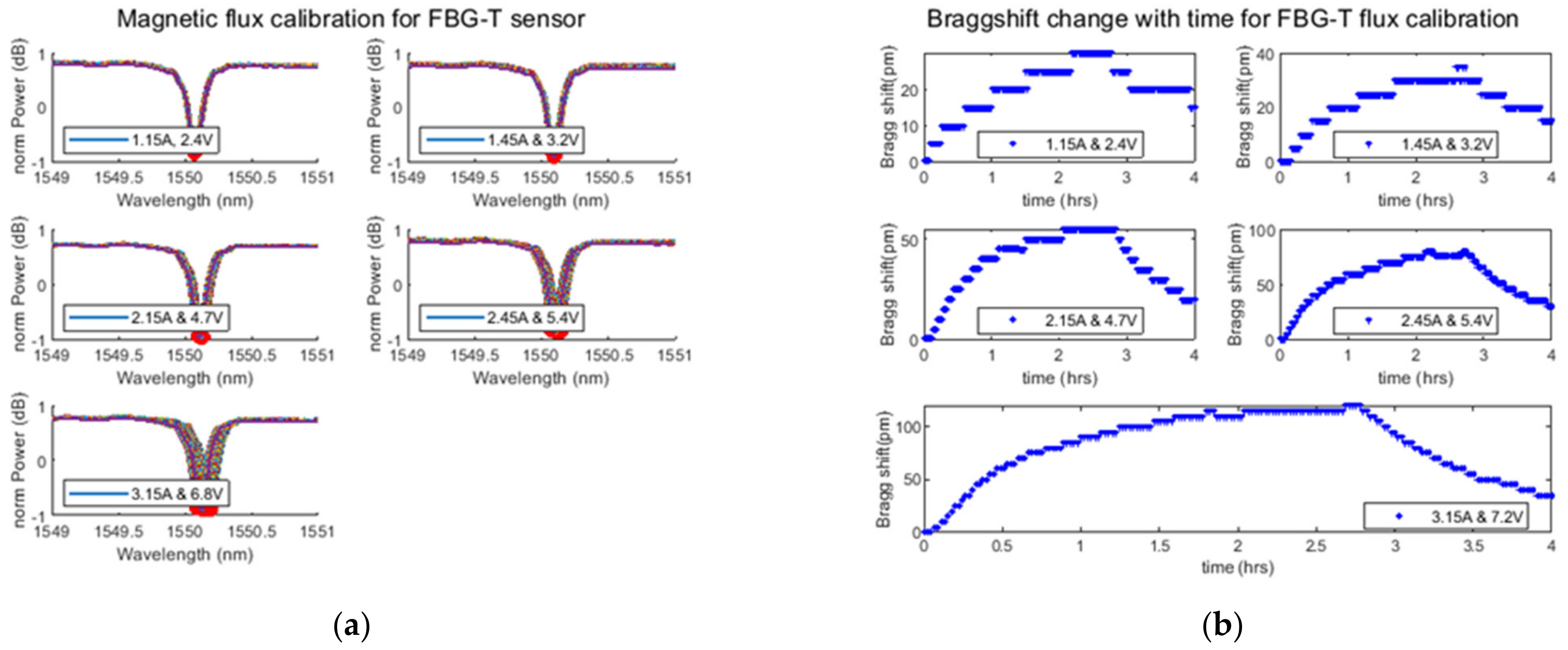

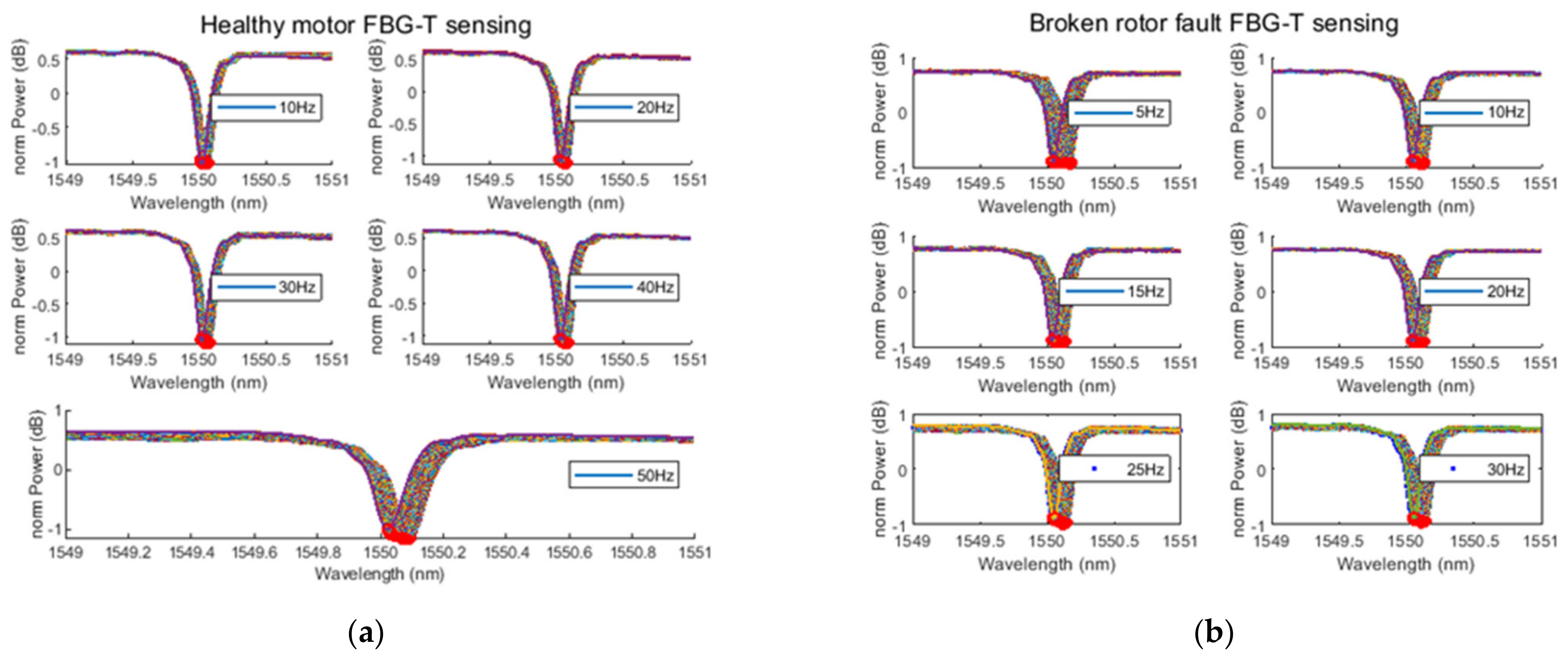

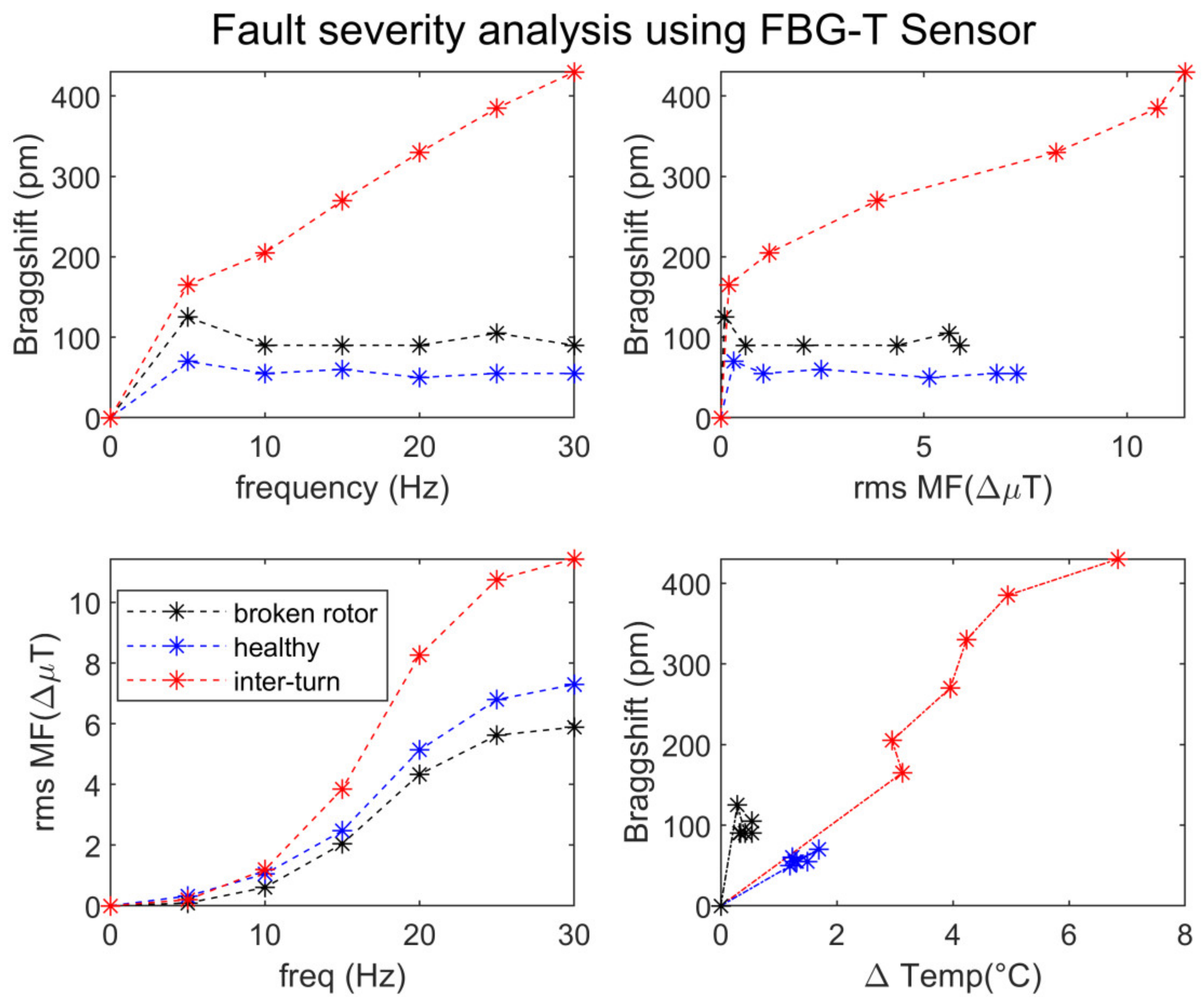
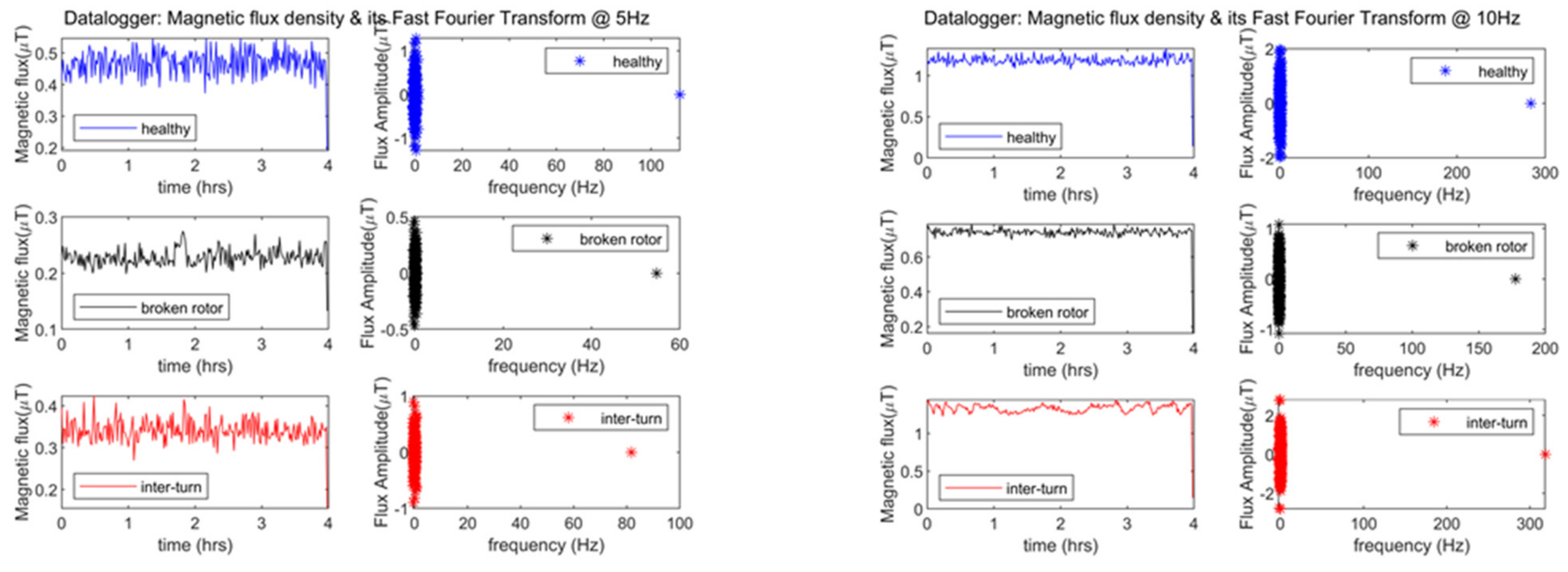


| Step | Activity Carried Out |
|---|---|
| Identifying the FBG sensor location | The location of the Bragg grating was first identified using a hot soldering iron. Step 1: The FBG optical fibre was connected to a broadband light source and OSA (in this case, dual function OSA), and the OSA was tuned to the desired settings, to clearly show the sensor spectrum. Step 2: The soldering iron was carefully brought into close proximity to the stripped section where the FBG was suspected to be inscribed. Step 3: The FBG spectrum responded to the high temperature of the hot soldering iron, and the location of the grating was estimated. |
| Bonding FBG to Terfenol-D | During bonding, it is crucial not to incorrectly bond the FBG as there are two ways this activity can be carried out: (a) applying the adhesive over the FBG surface and then place the terfenol-D over the adhesive, (b) placing the terfenol-D over the FBG surface, before applying the adhesive over the alloy and the grating.The latter was preferred because it increases the contact surface area between the FBG and the alloy. Given that FBG sensing relies largely on the relative contact between the grating and the measurand, the former option would create an adhesive layer between the alloy and the grating, which could have an adverse effect on sensor performance. Step 4: The terfenol-D was placed over the FBG surface and Loctite 416 adhesive was gently applied across the alloy to bond it to the grating. It was left to cure for several hours; although, it cured within minutes. The FBG spectrum was still visible on the OSA whilst the terfenol-D was being bonded onto the FBG. |
| Tubing FBG-T | Step 5: The composite sensor (FBG-T) was then disconnected from the OSA and carefully inserted into an acrylic tube. Before the insertion, the acrylic tube was tested to confirm it was magnetically insensitive, by measuring the external flux from one motor with and without the tube using a Gaussmeter. Both readings were exactly the same. |
| IM-DC Machine Coupling | Step 6: The test machines (induction motors), each in turn, were coupled to a DC motor, which acted as the driven load, using rotor shaft couplings of appropriate diameters. |
| VSD/IM Connection | Step 7: The coupled IM was then connected to a variable frequency drive (VFD). The VFD had a three phase input, where the IM was connected, and a single phase output, which was connected to a 230 V utility supply. |
| OSA/Light Source/PC Connection | Step 8: The FBG-T was then connected to a dual-function OSA/light source via pigtails. The OSA was thereafter connected to a PC via a GPIB adapter, where LabView was used to export the numerical spectral data to MS Excel. |
| LabView/MATLAB Interface | Step 9: The exported data were then imported into MATLAB for data analysis. |
| Frequency (Hz) | RMS Flux Density (µT) | Max Bragg Shift (pm) during Operation | Max Bragg Shift (pm) during 20 Hours | Mean Temperature (°C) during Operation | Duration of Operation |
|---|---|---|---|---|---|
| 5 | 0.5671 | 5 | 10 | 19.8846 | 2 h per frequency |
| 10 | 1.0716 | 20 | 20 | 21.56 | |
| 15 | 1.2873 | 10 | 15 | 20.5692 | |
| 20 | 1.5617 | 20 | 25 | 20.9077 | |
| 25 | 1.7142 | 30 | 35 | 19.6077 | |
| 30 | 1.7784 | 30 | 30 | 20.0538 |
| Frequency (Hz) | RMS Flux Density (µT) | Max Bragg Shift (pm) during Operation | Max Bragg Shift (pm) during 20 Hours | Mean Temperature (°C) during Operation | Duration of Operation |
|---|---|---|---|---|---|
| 5 | 1.1410 | 30 | 35 | 24.1615 | 2 h per frequency |
| 10 | 4.1770 | 50 | 55 | 23.96 | |
| 15 | 7.1228 | 45 | 55 | 24.8692 | |
| 20 | 9.5393 | 55 | 65 | 25.4154 | |
| 25 | 11.1127 | 45 | 65 | 25.1 | |
| 30 | 12.1654 | 45 | 70 | 25.6846 |
| Frequency (Hz) | Healthy | Broken Rotor | Inter-Turn | Healthy | Broken Rotor | Inter-Turn |
|---|---|---|---|---|---|---|
| Bragg Shifts (pm) | ΔTemp. (°C) | |||||
| 5 | 70 | 125 | 165 | 1.6910 | 0.5340 | 3.1280 |
| 10 | 55 | 90 | 205 | 1.2730 | 0.4170 | 2.9520 |
| 15 | 60 | 90 | 270 | 1.2300 | 0.3400 | 3.9530 |
| 20 | 50 | 90 | 330 | 1.1910 | 0.3240 | 4.2340 |
| 25 | 55 | 105 | 385 | 1.3080 | 0.5380 | 4.9440 |
| 30 | 55 | 90 | 430 | 1.4910 | 0.5340 | 6.8460 |
| Magnetic flux density | ||||||
| 5 | 0.468905 | 0.2284 | 0.3414 | (μT) | ||
| 10 | 1.186085 | 0.7428 | 1.3313 | |||
| 15 | 2.614542 | 2.1804 | 3.9901 | |||
| 20 | 5.280447 | 4.4652 | 8.4094 | |||
| 25 | 6.922083 | 5.7436 | 10.8951 | |||
| 30 | 7.423125 | 6.0265 | 11.5808 | |||
Publisher’s Note: MDPI stays neutral with regard to jurisdictional claims in published maps and institutional affiliations. |
© 2022 by the authors. Licensee MDPI, Basel, Switzerland. This article is an open access article distributed under the terms and conditions of the Creative Commons Attribution (CC BY) license (https://creativecommons.org/licenses/by/4.0/).
Share and Cite
Alalibo, B.P.; Ji, B.; Cao, W. Short Circuit and Broken Rotor Faults Severity Discrimination in Induction Machines Using Non-invasive Optical Fiber Technology. Energies 2022, 15, 577. https://doi.org/10.3390/en15020577
Alalibo BP, Ji B, Cao W. Short Circuit and Broken Rotor Faults Severity Discrimination in Induction Machines Using Non-invasive Optical Fiber Technology. Energies. 2022; 15(2):577. https://doi.org/10.3390/en15020577
Chicago/Turabian StyleAlalibo, Belema P., Bing Ji, and Wenping Cao. 2022. "Short Circuit and Broken Rotor Faults Severity Discrimination in Induction Machines Using Non-invasive Optical Fiber Technology" Energies 15, no. 2: 577. https://doi.org/10.3390/en15020577







